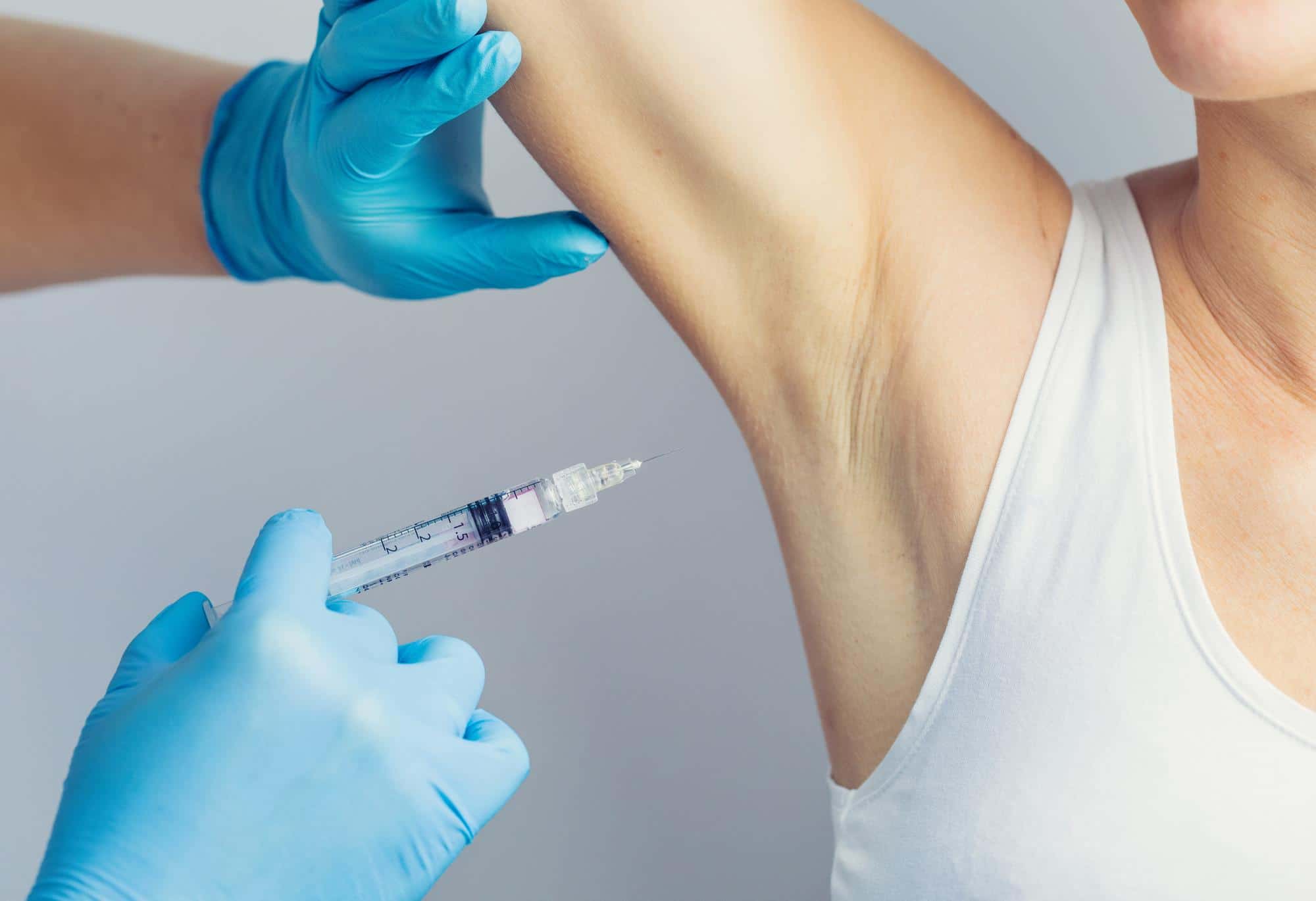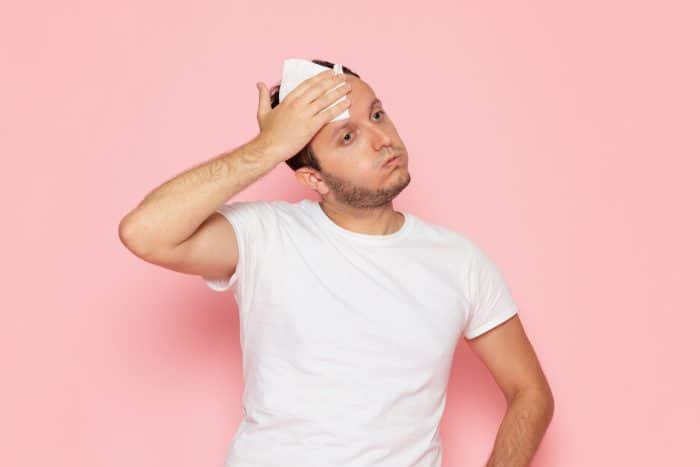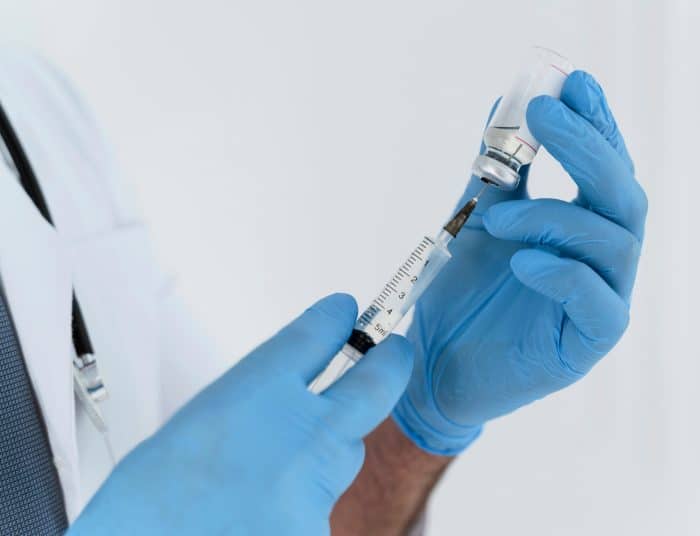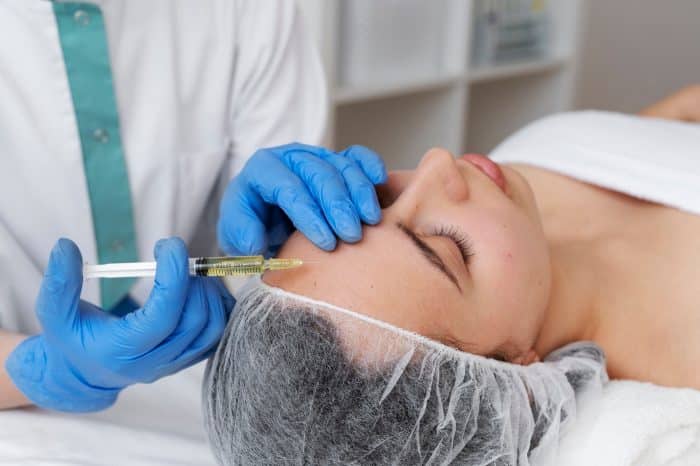
Hyperhidrosis affects a significant portion of the population, with studies indicating a prevalence rate ranging from 0.6% to 16.7% globally. This condition causes physical discomfort and emotional and social distress, impacting the quality of life for millions.
However, Dysport presents itself as a solution to this problem. This neurotoxin therapy, known for its cosmetic applications, also offers therapeutic benefits for those suffering from excessive sweating. Dysport reduces sweat production by inhibiting nerve signals and restoring normalcy to daily activities.
In this article, we will explore how Dysport treats excessive sweating and significantly improves a patient’s quality of life.
Key Takeaways
- Dysport neurotoxin therapy offers a non-surgical option for managing excessive sweating in targeted areas such as the underarms, palms, and feet.
- Understanding the underlying mechanisms of hyperhidrosis and its impact on a patient’s daily life is crucial for effective treatment.
- Injection techniques, dosage considerations, and treatment protocols play a significant role in successfully applying Dysport for hyperhidrosis management.
Understanding Hyperhidrosis and Its Impact
Hyperhidrosis is a medical condition that causes abnormal and excessive sweating. This sweating can occur in unusual situations, such as cooler weather or without any trigger. It typically affects specific body parts with a high concentration of sweat glands, such as the hands, feet, underarms, and face.
An individual with hyperhidrosis can experience significant discomfort, social anxiety, and a decreased quality of life. There are two main types of hyperhidrosis:
- Primary Hyperhidrosis: This type usually affects the hands, feet, underarms, and face. Other medical conditions or side effects from medication do not cause it. The exact cause is unknown, but it may be related to overactivity in the sympathetic nervous system.
- Secondary Hyperhidrosis: Unlike primary, secondary hyperhidrosis is due to an underlying health condition or medication. Secondary hyperhidrosis can affect the entire body or specific areas and may not be symmetrical. Some common causes of secondary hyperhidrosis include overactive thyroid, menopause, certain medications, and neurological disorders.
Impact on Daily Life and Quality of Life

Hyperhidrosis can significantly impact a person’s daily life and overall well-being. Here are some key ways it can affect individuals:
- Physical Discomfort: Constant sweating can lead to physical discomfort, including irritation, chafing, and skin infections.
- Social Anxiety: The fear of embarrassment due to visible sweating can lead to social withdrawal and anxiety in situations like handshakes, public speaking, or physical contact.
- Emotional Impact: Hyperhidrosis can negatively affect self-esteem and confidence, leading to feelings of isolation and depression.
- Occupational Limitations: The condition can also complicate professional activities, especially those requiring a firm grip or using electronics. Moreover, changing clothes, applying antiperspirants, and washing can be time-consuming and frustrating.
Introducing Dysport Neurotoxin Therapy for Hyperhidrosis
Dysport is an FDA-approved neurotoxin primarily used for cosmetic purposes, such as reducing wrinkles. However, it has also gained recognition for its efficacy in treating hyperhidrosis. Like Botox and Xeomin, Dysport contains botulinum toxin type A, which temporarily paralyzes specific muscles or glands.
Dysport treatment for hyperhidrosis works by blocking the release of acetylcholine, a neurotransmitter responsible for stimulating sweat glands. When injected into the affected area (such as the underarms, palms, or feet), Dysport inhibits excessive sweating by reducing sweat gland activity. The treatment is precise and localized, minimizing side effects.
Targeted Areas for Dysport Injections
- Underarms (Axillary Hyperhidrosis): When treating hyperhidrosis, the underarms are one of the most targeted areas. Healthcare professionals can use Dysport to reduce sweating, involving multiple tiny injections. This strategy ensures even coverage for Dysport treatment.
- Palms (Palmar Hyperhidrosis): This condition can be a significant social concern. Fortunately, Dysport injections can relieve those with excessively sweaty palms. As a specialist carefully administers Dysport into the palms, it targets the sweat glands responsible for palm sweating.
- Feet (Plantar Hyperhidrosis): Excessive sweating on the feet can lead to discomfort, odor, and fungal infections. Dysport can also be effective for treating sweaty feet. Precise injections into the soles of the feet help control excessive sweating, allowing patients to wear open-toed shoes without discomfort.
Injection Techniques and Dosage Considerations

When considering Dysport therapy for hyperhidrosis, it’s essential to understand the injection techniques, dosage, and potential side effects. The most common sites for Dysport injections for hyperhidrosis are the underarms, palms, and soles of the feet. A qualified healthcare professional chooses the injection sites based on the patient’s pattern of sweating.
The procedure involves a series of small injections directly into the affected area. The doctor administering the treatment may numb the patient’s skin beforehand. They can also use ice or vibration anesthesia techniques to minimize the patient’s discomfort.
Dosage Considerations Based on the Area of Treatment
- Underarms: A typical dosage for axillary hyperhidrosis ranges from 50 to 100 units of Dysport per underarm.
- Palms and Soles: The palmar and plantar hyperhidrosis dosage can vary, but it generally starts at 50 units per palm or sole and may be adjusted based on response and side effects.
Potential Side Effects and Complications
Dysport injections are generally well-tolerated, but some temporary side effects can occur. The most common side effects include pain, redness, or swelling at the injection site. Other side effects include temporary weakness in the injected muscles and headaches. Most patients also get bruising from Dysport, but this effect can quickly go away by gently applying ice to the affected area.
However, there are also severe complications associated with this procedure. These rare effects can include muscle weakness, difficulty swallowing, or signs of an allergic reaction. It’s crucial to discuss these risks with a healthcare provider before treatment.
It’s important to note that the exact dosage and injection technique should be tailored to each individual by a qualified healthcare professional, considering the severity of hyperhidrosis and the patient’s medical history.
Treatment Protocols and Expected Outcomes

Managing hyperhidrosis with Dysport involves specific treatment protocols and considerations for optimal outcomes. This neurotoxin injection offers a convenient and effective way to manage excessive sweating in various parts of the body.
Frequency of Dysport Injections for Hyperhidrosis
The frequency of Dysport injections for hyperhidrosis depends on several factors, including:
- Severity of Sweating: Individuals with more severe hyperhidrosis may require more frequent injections compared to those with milder cases.
- Area Treated: The treated area also plays a role. Sweat glands in some places, like the armpits, regenerate faster than others, requiring more frequent touch-up injections.
- Individual Response: Everyone’s body metabolizes Dysport at a slightly different rate. Some people may see longer-lasting effects than others.
Generally, Dysport injections for hyperhidrosis are repeated every 3 to 6 months. However, this timeframe can vary depending on the factors mentioned above. The administering healthcare professional will recommend the most suitable injection schedule based on a patient’s needs and response to treatment.
Long-Term Outcomes and Maintenance of Treatment
Patients typically experience reduced sweating within 2 to 3 days after the injections. The full effects of Dysport are usually observed within 1 to 2 weeks. Its results can last 3 to 6 months, but some patients may enjoy the benefits for up to 9 months.
- Consistency: Consistent follow-up appointments with your healthcare professional are crucial for maintaining long-term dryness and managing hyperhidrosis effectively. To maintain dryness, repeat treatments are recommended when the effects start to diminish, which is generally no sooner than 12 weeks following the previous session
- Individual Variability: Long-term outcomes vary among individuals. Some may experience prolonged relief, while others may need more frequent injections.
- Quality of Life: Dysport can significantly enhance quality of life by reducing sweating-related discomfort and social anxiety.
Conclusion
Dysport neurotoxin therapy emerges as a valuable non-surgical tool for managing hyperhidrosis. It provides targeted relief from excessive sweating in the underarms, palms, and feet.
By understanding the causes of hyperhidrosis, employing careful injection methods, and tailoring dosage and treatment plans, medical professionals can effectively leverage Dysport to improve patients’ quality of life and minimize the disruptions hyperhidrosis causes in daily activities.
With proper assessment, treatment, and follow-up care, Dysport injections can be a powerful weapon in the fight against hyperhidrosis.
About: DoctorMedica is your trusted supplier of top-quality dermal fillers, viscosupplements, and more. If you’re looking to buy Dysport wholesale for your practice, the sales representatives at Doctor Medica can give you guidance.
FAQs
1. What is Dysport made from?
Dysport is composed of the active ingredient botulinum toxin type A, and its inactive ingredients include human albumin and lactose.
2. How can Dysport treat excessive sweating?
Dysport treats excessive sweating, or hyperhidrosis, by blocking the nerve signals that stimulate sweat glands. Its formulation reduces sweat production in targeted areas such as underarms, palms, and feet
3. Is Dysport safe to use?
Dysport is considered safe and was approved by the FDA for various therapeutic uses, including treating certain muscle disorders and cosmetic improvements.
References
Lima SO, De Santana VR. The prevalence of hyperhidrosis worldwide. In: Springer eBooks. ; 2018:33-38. doi:10.1007/978-3-319-89527-7_5
Dysport (AbobotulinumtoxinA) FDA approval history. Drugs.com. https://www.drugs.com/history/dysport.html
Related Articles
Joanna Carr
Neauvia Filler Vs Juvederm – A Thorough Comparison
A comprehensive comparison of two premium dermal fillers, exploring their unique formulations, benefits, and ideal applications.
Joanna Carr
Monovisc Injection – All About the Treatment
Monovisc injection is a treatment for osteoarthritis knee pain, providing relief by lubricating and cushioning the joint.
Joanna Carr
Dysport Under Eye Wrinkles: Efficacy and Considerations for Treatment
Healthcare professionals can use Dysport off-label to smooth expression lines and treat muscle-related conditions in areas like the chin.


